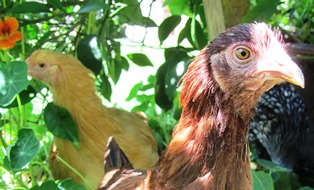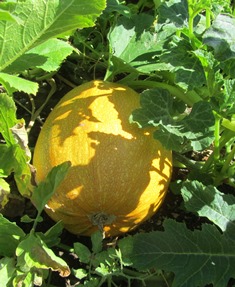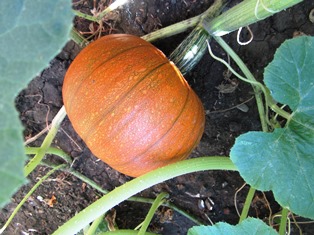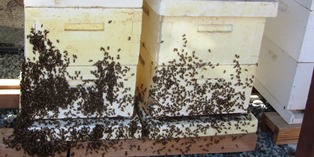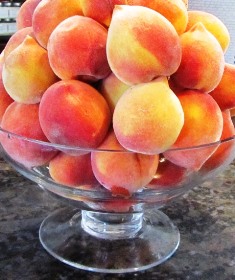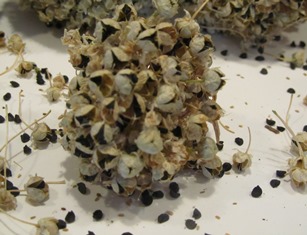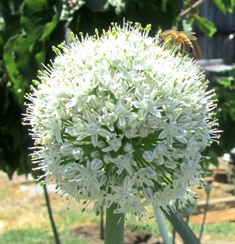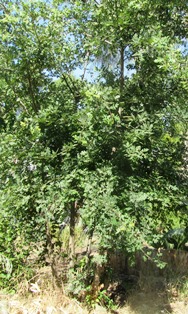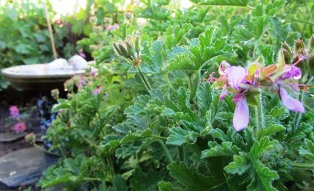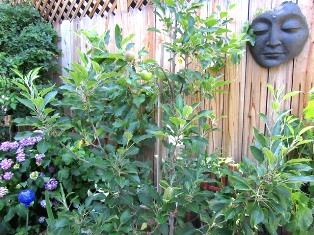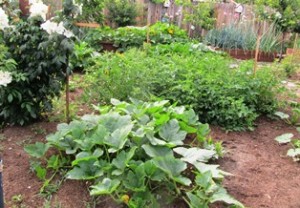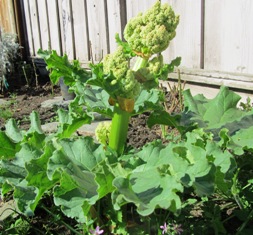Archive for the 'Gardening' Category
Butternut Squash and French Sugar Pumpkins Takes Over the Garden
My organic vegetable garden is a mess of vines. Among the varieties of heirloom tomatoes, Armenian cucumber, summer squash, and eggplant that I planted in late spring, I also tucked in my favorite Butternut squash and French sugar pumpkins. The vines, although producing prolifically, have taken over. I can hardly get in to pick the tomatoes and I can’t see my chickens for the vines.
Next year, I’m going to try Bush Buttercup from Baker Creek Heirloom Seeds. The squash has the same orange flesh and firm rind but grows on bushy plants that say compact and grow between three and four feet high. The fruits weigh three to four pounds.
And maybe, with permission of my neighbor who has a large growing area adjoining our property I might plant Boston Marrow (first documented in 1831). That orange-fleshed squash can weigh up to 15 pounds. A native American tribe distributed the seed to settlers in New York and from there, the seed went to gardens in Massachusetts and spread elsewhere.
Another squash from that Baker Creek Seeds that I’d like to growl is Iran. Collected in Torbat-e-Heydariyeh, Iran in 1940 and preserved at the United States Department of Agriculture since, this is one of the loveliest of the ornamental squash. Orange color mottles its sea-foam green rind.
The pumpkins in my garden are Rouge Vif D’Etampes. I grew these with great success last year and saved the seed of this old French heirloom. A variety of seed companies carry this seed, including Baker Creek Seeds that notes it was one of the “most common pumpkins in the Central Market in Paris in the 1880’s . . . can be picked small and fried.”I like this one especially for pie making.
Squash and pumpkins taste great in Italian, Mexican, French, Middle Eastern, and American recipes. Rich in flavor and nutrients, squash and pumpkins can be made into soups, breads, mixed-vegetable dishes, and pies or can be baked, boiled, steamed, or fried. Even the blossoms are edible. So, it should be apparent why I need more room in my garden. Now to figure out how to keep it orderly.
Stealing Away to Visit the County Fair
My daughter dropped by for a girl’s day out at the county fair. Summer chores are endless so taking a day off riddled me with guilt–and guilty pleasure.
We strolled under ancient, white bark sycamore trees that towered 50 to 100 feet above us. The first thing we saw as we entered the arched fair-grounds gate were goat pens. The cute little milking goats drew us over, but the odor of mounds of fresh horse manure turned us away. We kept on walking.
We moseyed over to see the sheep with their docked tails (apparently sheep like to chew on the tails of other sheep, so docking the tails eliminates pain and suffering and is more hygienic). We thought the baby goats were adorable. We marveled at how the pigs appeared so pink, healthy and robust. We couldn’t help but stare at the massive bellies and large bags of the dairy cows.
Embarking on the path to the exhibit halls, we relished how cool it was inside, a veritable respite from the heat. We strolled down aisles of quilts, art by high school students, and displays of jewelry. Then it was time to check out the jams. The entries of strawberry dominated the competition, but some included jam made with fig, plum, or rhubarb.
During the dessert competition, pies, brownies, and cakes beckoned us to peer into the glass display shelves. My daughter lamented that she wished they were for sale, reminding us it was time to eat.
We passed on the roasted corn on the cob and cotton candy, choosing simple tacos and Pennsylvania Dutch-style funnel cakes. I washed my meal down with the hibiscus-flavored drink sitting next to a dispenser of white horchata while my daughter stuck with water.
Before we left the exhibit halls and animals, I wanted to see the chickens. That competition must have happened on a different day, so I wandered over to the peacock pens next to the pigeons, finches, and parakeets. The peacocks were lovely but there were no peahens.
We checked out the bunny cages (I didn’t know there were so many kinds of rabbits) and decided against even looking at the reptiles (I tend to dream about them once I see them–and snake dreams aren’t usually pleasant).
All that walking and sensory stimuli wore me out. By the time we arrived home in the late afternoon, I needed a nap. I thought a day off was supposed to rejuvenate you. Instead, mine had done me in, but the trip to the fair gave me gobs of ideas for my cozy mystery series.
Puzzling through a Cozy, Weeping at a Memoir, and Forgetting the Peach Pie
I couldn’t breathe in yesterday’s heat. But with so much work to be done around the farmette, I soldiered on, staking heirloom blue tomatoes. I hadn’t finished canning my organic apricots and now the plums and peaches were ready. I felt overwhelmed and longing for cool spot to sip tea, rest, and read.
We had already removed the apricots from our “torture tree” since we’ve been unable to surmount its many problems after planting it five years ago. Carlos wasted little time chain-sawing it down. I deadheaded the roses, while he dug out the stump.
Then with a clear view to our hives, we quickly realized that the we needed to suit up and install extenders or the bees would swarm. Even as we felt the urgency, we realized there were also dozens of other chores screaming for our attention.
I told myself that breezes would soon blow inland from the Carquinez Strait, a channel of the San Francisco Bay where the San Joaquin and the Sacramento Rivers flow to the ocean, but by mid-afternoon, nary a leaf moved on the apricot, plum, and pomegranate trees. By four o’clock when the wind finally did kick in–the air wasn’t cool as it usually was. The winds blew strong and stifling hot and threatened to suffocate anyone still working outside.
Abandoning the outside chores, I retreated indoors and turned on the air conditioner. Seeing the lug of apricots and crock of peaches resting on the kitchen counter, I groaned. The jam had to be made, but I couldn’t face stirring boiling fruit on a hot stove.
Deciding to use up some of the fruit for a simple after-dinner dessert, I flipped through the pages of a few cookbooks. Maybe a cobbler would do or a peach pie. I really didn’t need a recipe for those, but in Country Cooking by Dori Sanders, I found an intriguing raisin-cinnamon crust that sounded tasty. I bet it would go with peaches but I probably could have baked it on the patio floor.
With a glass of sweet tea and an armload of paperbacks and hardcovers, I curled up on the couch and finished reading Murder is Binding, Lorna Barrett’s debut book in her cozy Booktown Mystery series. I love this author and her writing, but soon figured out who done it. Still, I read to the end; you never know when a clever twist might show up.
Next, I read the last few pages of A Tuscan Childhood by Kinta Beevor. At bedtime, I’d been savoring the chapters of that book like pieces of rich, dark chocolate. Beevor’s evocative descriptions of her bohemian childhood in Tuscany captured my imagination, drawing me in so completely I could almost smell the wild thyme, pine needles, and rocky Tuscan terrain in the searing, summer heat. Like Frances Mayes (Under the Tuscan Sun), who wrote a quote for the cover, I felt sad when Beevor’s lovely memoir ended.
Returning to the stack, I selected another memoir, The Orchard, by Theresa Weir. I’d bought the book on impulse during a trip to the farmers’ market at Todos Santos Plaza, our downtown green space surrounded by bars and banks and, of course, a second-hand bookstore. Drastically marked down, the book had been summarily deposited on a set of moveable shelves, and rolled outside the storefront for a quick sale.
The artist and writer in me understood immediately why I had picked it up and purchased it: the cover art pictured a young couple in a loving embrace, standing in lush green grass surrounded by apple trees. But there was something in that image that evoked sadness, like a bittersweet dream of a time past, viewed through a long lens.
As the descendant of five generations of farmers, I suspected Weir’s book would resonate with my own experiences of farm life in America’s heartland with bone-chilling winters of snow and ice and sweltering summers when you prayed for rain. What I didn’t expect was exquisite writing and the juxtaposition of love against the deadly realities of widespread pesticide use on the farms that ushered me into her story and swept me along. I finished that book in one sitting and will long be haunted by it.
I felt guilty for having only paid pennies for Weir’s book. A pittance for a tale that evolved out of all she had lived through. Less than the price of bus fare to journey with her as she pieced together scenes from her life in the Heartland. In every page, I was with her as she struggled, never abandoning her dreams. She learned as I had how to tuck them away while you dealt with the realities of a hard life with heart-breaking lows and highs that reached euphoria. But there were scenes she left out, only hinting at experiences she said she would “never talk about.” The truth is, I wept after putting down her book.
When a reader identifies so closely with a character in a story (and this was Weir’s personal narrative of her life), he or she rides the emotional ups and downs with that character. Good writers understand how to tug at their readers’ emotions and milk the drama. Theresa Weir had skillfully threaded a leitmotif of darkness and light, joy and sorrow, pain and healing through her story, but never once did I feel manipulated. Every sentence of The Orchard rang true.
I couldn’t read anymore after putting that book down. As I made dinner, I thought of how many scenes in her life resonated with mine. Even the widespread pesticide use on farms and the stubbornness of farmers to change.
I thought about Rachel Carson’s famous book, Silent Spring, that sounded the wake-up call to farmers everywhere about the dangers of chemicals in fertilizers, pesticides, and herbicides. So many small farms have been overtaken by agribusinesses these days and still the chemicals are used. I decided to forgo making the peach pie.
With the heat of the day gone, I opened the windows and stretched out between freshly washed sheets. I listened to the rustle of oak and eucalyptus leaves. To crickets and the unseen critters that make noises in the night. I listened to the soft voices of my Lebanese neighbors chatting in their orchard with relatives.
As dreams beckoned, I could almost smell the fresh lilacs that Theresa Weir had written about in her memoir. Their cloying scent had filled her grandmother’s kitchen just as they had filled my grandmother’s, my mother’s, and mine. I wondered if the lilacs would ever disappear or if the world would one day wake up to find the honeybees gone, the fruit trees without fruit, and the berries and other sweet produce in our gardens and orchards reduced to a memory.
Harvesting Seeds from Onion Heads
The red and yellow onions I planted during winter here on the farmette have produced lots of fat bulbs. Now that warm weather has arrived, the plants have sent up spikes with a flower head in a process called bolting.
I’ve been using the onions in culinary creations. Now that they are bolting, I’m saving the seed heads for my next round of planting (when the weather gets cooler again).
When the seed heads I’ve collected have dried a bit, black seeds will spill out. I shake them onto paper and then store them in paper envelopes where they can dry out even more.
The benefits of growing onions from seed rather than sets (also called seedlings) is that they perform better, are less susceptible to disease, bulb up somewhat quicker than seedlings, and store better. The seeds germinate quickly (7 to 10 days) and may be eaten in as early as 8 to 10 weeks.
Growing onions is easy. Broadcast your seed in a prepared bed when the weather is warm and all danger of frost has passed. Barely cover with soil (roughly 1/4 inch) and keep damp until seeds have germinated. If you prefer, start some onion seeds in flats to set out in the garden as seedlings.
Harvest bulbs throughout the growing season or wait until the tops flop over. Store onions in the refrigerator in a nylon stocking wrapped individually between onions to maintain freshness. The National Gardening Association has some good tips for harvesting and storing onions. See http://www.garden.org/foodguide/browse/veggie/onions_harvesting/501.
With so many onion types from which to choose, decide how you’ll use each in the kitchen and then grow various heirloom types, depending on purpose and flavor. And . . . don’t worry if next spring, you discover your onions bolting. It’s a good thing to have a seed source for such an important kitchen staple.
Germinating Seeds
On the property behind my farmette, a Sierra Live Oak tree drops acorns in abundance. The acorns sprout into seedlings, ensuring new generation of the tree.
The life cycle of the oak tree begins with acorn (the seed of the oak). As with all seeds, the acorn contains the genetic information for germinating and growing into the specific type of plant (in this case, a Sierra Live Oak).
This is the secret of seeds, they are alive and many remain viable, able to germinate for 1-5 years. Seeds link one generation of a plant to the next. Seeds for woodlands as well as vegetable and flower gardens widely vary in size, shape, color, and the amount of time it takes for germination.
Seeds require moisture and warmth to germinate. Some–such as the flower garden varieties of columbine, petunia, begonia, and snapdragon–also require light to germinate. You would not plant those seeds under the soil, but rather scatter them on top of moistened soil or seed-starting mix.
Light, however, is not necessary for most seeds to germinate. Outside in the garden, seeds require soil and air temperatures to be warm (tomatoes need the ground’s night-time temperatures to be around 55 degrees Fahrenheit) before they’ll set up blossoms and fruit. Moisture is a requirement, too, but too much water destroys the seed.
Pre-sprouting is the process of sprouting seeds before they are planted in their permanent places in the garden. In cold climates, pre-sprouting can give plants (especially the heat lovers like tomatoes, peppers, and eggplant) a jumpstart in the spring since they are started indoors and put out when the warm days arrive.
Seed sown directly into the earth can take a week or more to germinate but seed pre-sprouted in your kitchen may take only a couple of days.
To sprout your seeds indoors, you’ll need to sprinkle them across a moistened (not dripping wet) paper towel and also cover them with moist paper towel. When inserted inside an unsealed plastic bag and placed in a warm area, your paper towel seed mat retains its moisture. Check it every day and spritz with water if necessary until the seeds germinate.
The small plants of germinated seeds that have not yet been planted into the garden are called seedlings. Plants in cells (like the seed flats you see in nurseries) need to have two to four sets of leaves before they are ready to transplant into the garden.
Gardening becomes a fulfilling hobby when you start plants for your garden from seed and nurture the seed through the process of germination into seedlings. Flats of cell packs (usually six or eight cells to one pack) and commercially prepared potting/planting mixtures make starting seeds for your garden fuss-free and easy.
Scented Geranium Leaves for the Garden and the Kitchen
Like the British monarch Queen Victoria, I am a lover of Pelargoniums, popularly called scented geraniums. Tucked in between a hedge of French perfume lavender, hydrangeas, and purple bearded iris in my garden is a rose-scented geranium with tiny pink flowers. I started it from a slip off my Lebanese-American neighbor’s plant and now it’s as large as a wine barrel. The varieties I grow aren’t just relegated to my garden; I have some in pots, within easy reach for culinary purposes.
My favorite, however, is the rose geranium. If I happen to brush against the leaves, the plant releases a heady perfume that scents the whole area like an old rose garden. Scented geraniums are actually unrelated to the true geranium of woodland habitat. The scented geraniums are of the genus Pelargonium, beloved of the Victorians, their monarch, my grandmother, and gardeners like me.
Indigenous to South Africa, the scented-leaf geraniums are half-hardy perennials in many parts of the United States. Once so popular there were 250 varieties or more, the plant fell out of favor after the Great War. Today’s gardener will find scents such as apple, apricot, chocolate, cinnamon, coconut, ginger, lemon, lime, mint, nutmeg, orange, pepper, pineapple, rose and strawberry, to name a few.
The leaves run the gamut of shapes, from deeply cut angles to round shapes that appear crinkled. Some leaves are smooth while others are leathery or velvety. The colors range from intense shades of green and yellowish-green to a reddish-purple hue. The lemon-scented Pelargonium crispum has small, green, crinkled leaves, for example, but the Pelargonium tomentosum features large and velvety leaves of a green-gray hue and yield a peppermint scent.
They need sun and a well-drained, slightly acidic soil. To propagate, take cuttings before the plant flowers. Keep the cuttings in water until roots form or put them in a planting mixture and keep moist until new leaves spr0ut.
Easy to grow, delightfully scented, with pretty little leaves and flowers, scented geraniums were beloved by our grandmothers and theirs before them. In any garden, they lend a generous helping of old-fashion charm. Plus, many of them can be used in homemade soaps and cosmetics. Cooks like them for their culinary uses as a scent source for sugars, or for tea, or as garnishes for cakes and salads and fruit dishes.
The process of making a scented sugar for tea or icing is quite simple. You’ll need a cup of sugar and a cup of leaves from a scented geranium. Try rose, lemon, or mint.
1. Gather a cupful of leaves
2. Thoroughly wash and dry the leaves.
3. Using one cup of sugar, alternate layers of 1 inch of sugar and a layer of leaves (some chefs say to slightly bruise to release more flavor).
4. Tightly screw the lid onto the jar.
5. Store in a warm place for 2 to 4 weeks
6. Remove the leaves (try sifting the sugar in a bowl to get all the leaves out)
7. Re-jar the scented sugar and use as needed.
Creating Sacred Space in Tandem with Nature
One of the first things I did after buying the farmette was to create a space to sit, rest, pray, and dream. Basically what I had to work with was an empty field with a tiny farmhouse in the middle. The house was a construction zone–not quiet and peaceful or nourishing to the spirit–so I need to create an outdoor sacred place for my sanity.
On the north/cool side of the house, my husband and I reinforced the fence and then planted some climbing roses, Japanese maples, hydrangeas, calla lilies, and irises. To anchor the space, we added a Cox Orange Pippin apple (a sweet dessert apple first grown at Colnbrook, Buckinghamshire, England, 1825).
Later, when I found the meditation mask, I decided to hang it on the fence, moving in a bench opposite (now my favorite place to read). A brick walkway leads to an arch that supports two Cecile Brunner climbing roses, opulently covered in tiny pink rosettes each spring. A blue reflecting ball offers a soft splash of cool color against the hydrangea pink florets. Finally, we tucked in blue-blooming dwarf agapanthus (Peter Pan) and fuchsia geraniums to give the space lushness and some cool, refreshing color.
There are many such places on our property that I’ve claimed as sacred space, but this one is my favorite. We redid the windows on the house’s north side so that the largest one looks out from our dining/living room onto this garden space. A fountain with soft gurgling water adds to the tranquility.
Besides art and possibly a water feature for your sacred space, you’ll want to think about the plants (tall, mid-size, and small), herbs, trees, climbing vines, and roses. I chose plants that I associate with my grandmother’s garden and the various gardens my mother created.
You don’t need a farmette to create sacred space. Rock gardens and arid landscapes, rooftop gardens, and cityscape corners and alleyways can be transformed as well. Work with the natural setting around you. Just stay in tune with what speaks to your spirit, gives ease to your heart, and restores peace to your mind as you create your sacred space.
Twelve Reasons to Grow Your Own Food
Doctors tell us we should eat fruits and vegetables for our health. Fresh is best. For more reasons to grow your own food, read on.
1. Enjoy Superior Flavor and Higher Nutritional Value
The flavor of produce that travels from your edible garden to your plate is far superior to that of store-bought varieties. Even before fresh produce reaches the bins of your local store, the fruits and vegetables must be picked, sorted, crated, and transported from suppliers t0 supermarkets and grocery stores. Time spent in transporting and storage can diminish food flavors and nutrient values.
2. Keep It Pesticide-Free
Go organic. Choose alternative methods (companion planting and organic sprays, for example) to treat garden pests and plant diseases. Organic farming starts with nourishing the soil, which in turn, nourishes the plants that nourishes a healthy body. Organically grown fruits and vegetables picked fresh, immediately prepared, and served are nutritionally superior than their commercially grown and stored counterparts.
3. Safeguard Your Health
Avoid the cancer-causing agents and toxic chemicals in pesticides that are commonly used on many commercially grown food products.
4. Cultivate Plant Diversity; Preserve History
Grow varieties of the vegetables and fruits you love. Or, choose cultivars that might have grown in your grandmother’s garden–a nod to preserving history. Or, plant varieties that have fallen out of favor, are unusual, or are even rare.
5. Lower Your Food Bill
Grow your own edibles and preserve them for later consumption (like freezing spring peas for a fall or winter meal). Preserving the bounty by drying or freezing or canning can reduce your grocery bills. Another cost and time saver is to grow hard-to-find varieties of heirloom herbs, vegetables, or fruits instead of tracking down sources for those items.
6. Expand Your Knowledge of Plants
Understanding the seed-to-harvest cycle in nature fosters deep appreciation for ecology and the environment and contributes to your knowledge about various plants’ needs for nutrients, water, light, and temperature. You also learn about treatment options for garden-variety pests and plant diseases. This wealth of information can be shared with younger generations who will inherit the responsibility of caring for the planet.
7. Get Exercise
You can still work out, albeit in the garden in the fresh air rather than in an indoors gym. Think about all the exercise you’ll get digging, planting, shoveling, watering, weeding, and composting. Gardening provides plenty of solid exercise and rejuvenates a weary spirit.
8. Reduce Your Stress
Time spent in a garden is restorative: it nourishes your spirit and reduces stress levels. In fact, just a few moments of deep breathing and thinking about birdsong, sunshine, fresh air, and healthy plants all around you–nature in all its splendor–can generate a positive mental attitude.
9. Alleviate Concerns about Food Safety and Quality
You know the quality of the food you bring from your edible garden to the table. You want the superior freshness, flavor, and food quality for your loved ones. The chances for food-borne illnesses of the kind that strike Americans every year and are often investigated by the Centers for Disease Control (CDC) are vastly diminished when you grow organic edibles and eat them as fresh as possible.
10. Preserve Our Planet’s Diversity
Choose seeds that are open-pollinated, non-GMO (genetically modified organism; the result of scientists engineering or modifying the genetic material of food plants). It may come as no surprise that the health of our nation has declined with the demise of small family farms even as there’s been a rise in the number of supermarkets and expansion of modern agribusiness. It’s no wonder people everywhere are getting behind buy-local, keep-it-local movements; participating in farmers’ markets, and engaging in urban homesteading where self-reliance is paramount.
11. Earn Extra Money
Selling your home-grown produce to others in your community means you can make possible the goodness of organic produce to others while earning a little money (hint: buy more seeds or otherwise reinvest in your garden).
12. Feel Good about Donating Excess Produce to a Food Bank
Your local food bank or (sometimes churches, too) will distribute donated produce to needy families. Let it be a source of joy for you that your gardening efforts have literally put food in the mouths of those in less fortune life circumstances.
Growing Peaches in Northern California
What could be more sublime that eating a juicy, ripe peach freshly plucked from the tree? If you have space in your Northern California backyard or garden, consider planting one or more peach trees.
In the Bay Area, peaches are fairly easy to grow. Depending on the cultivar, they are heavy bearing. We planted a classic gold Elberta and some early-bearing Desert Gold peaches two years ago. Already, both trees are loaded with peaches.
I ate a Desert Gold peach off the tree today. It was ripe on one side and still a little crunchy on the other. Another week, and they’ll all be ready for a cobbler. The Elberta peaches will not be ripe until late July or early August.
Peaches are best eaten fresh, in my opinion. But they also freeze well or you can make them into jam, preserve them with spices, or blend up a batch of chutney or baby food. Your best bet is to plant peach trees during bare root season because they are cheaper and more plentiful then. Right now (second week of May), nurseries have replanted their bare root trees into pots.
One of my favorite nurseries in the Bay Area is Alden Lane Nursery in Livermore, California. The nursery carries hundreds of fruit and nut trees and thousands of roses. The oak trees on the property are 300 years old and one has a community of honeybees dwelling in the tree. It’s a great time to visit the nursery. For a list of offers, see http://www.aldenlane.com/media/softprogram.pdf.
Peaches need a lot of sunshine, high nitrogen fertilizer, and water to perform optimally. They also suffer from peach leaf curl, a fungus that can be easily treated with a fixed-copper spray. Dormant oil will control scale if they get it. The trees will live for 15 to 20 years.
Prolific producers, peaches need fruit thinning early on to yield larger fruit and avoid branch breakage. See the University of California’s Master Gardener program tip sheet for more information at http://homeorchard.ucanr.edu/Fruits_&_Nuts/Peach/.
If you love peaches, it’s not too late to plant a tree in your backyard for a bountiful crop of late spring/summer fruit.
Rhubarb–That “Pie Plant”
In my grandmother’s time, rhubarb’s moniker was the “pie plant” for the simple reason that the tart flavor of its canes nicely tempers the cloying sweetness of other fruits.
Rhubarb, long treated as a fruit, is actually a vegetable. In bygone days when tariffs on imported vegetables were higher than on fruit, a New York court decided in favor of labeling rhubarb as fruit for the purposes of taxation and tariff regulations.
One of the first edibles in the spring garden, rhubarb pushes up leaf stalks or canes (what botanists call petioles) with large leaves. The leaves are are high in oxalic acid and thus poisonous to consume (when harvesting, cut off the tops and discard; snap off the canes for cooking).
Rhubarb stalks or canes, when cooked with sugar or apples (to sweeten), are delicious in pies, jams, sauces and fruit tarts.
Rhubarb is easy to grow (in warm climates, it grows year-round). In cold climates, its leaves and canes will die but the rhizome root will generate new shoots come spring. But if it blooms, cut off the bloom to ensure the root continues to produce canes.
The plant can also be grown in large containers or in greenhouses. It is not fussy about soil, produces new canes year after year, and loves sunlight.
Consumers love those red canes, but rhubarb canes, depending on the variety, aren’t always red–some are light green or pink speckled. The flavor of the light green canes, the type growing on our farmette, has the most robust flavor.
While creating a space for some new plants, we decided to dig out one of our rhubarb plants. That little rhizome I put in the ground four years ago had produced roots 20 inches into the earth. Above ground the plant had grown roughly three feet high and as wide. We will divide it and replant, since it’s a good idea anyway to divide every 3 to 4 years.
We grow Victoria, an old variety with a tendency to flower (or bolt). We prefer to remove those flower spikes in order to keep the plant producing new canes and leaves. Blooms tend to waste the plants resources, see http://www.gardeningknowhow.com/edible/vegetables/rhubarb/rhubarb-bolting.htm. Also see, http://www.hort.purdue.edu/ext/rhubarbflowers.html
In an upcoming posting, I’ll include some recipes for using rhubarb from your garden. In the meantime, consider the different varieties available and perhaps try planting a new and different cultivar. See, http://www.rhubarbinfo.com/varieties.
 Facebook
Facebook Goodreads
Goodreads LinkedIn
LinkedIn Meera Lester
Meera Lester Twitter
Twitter





